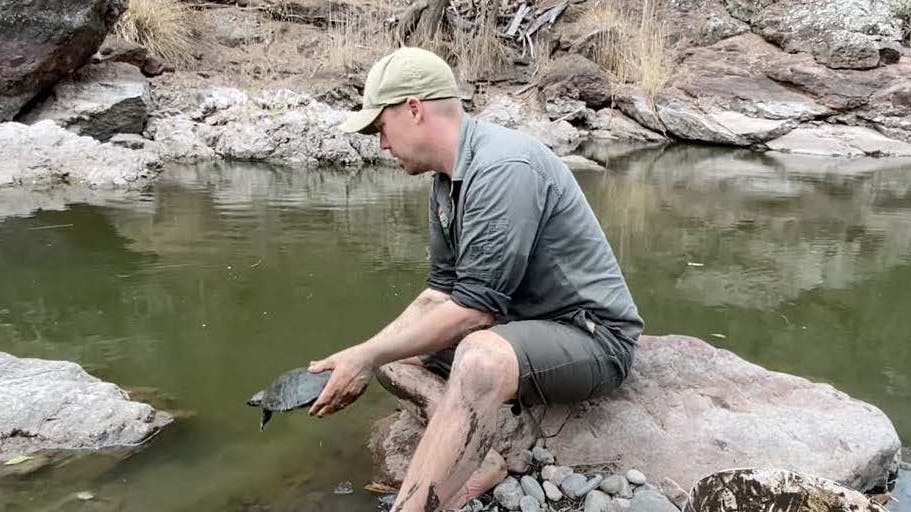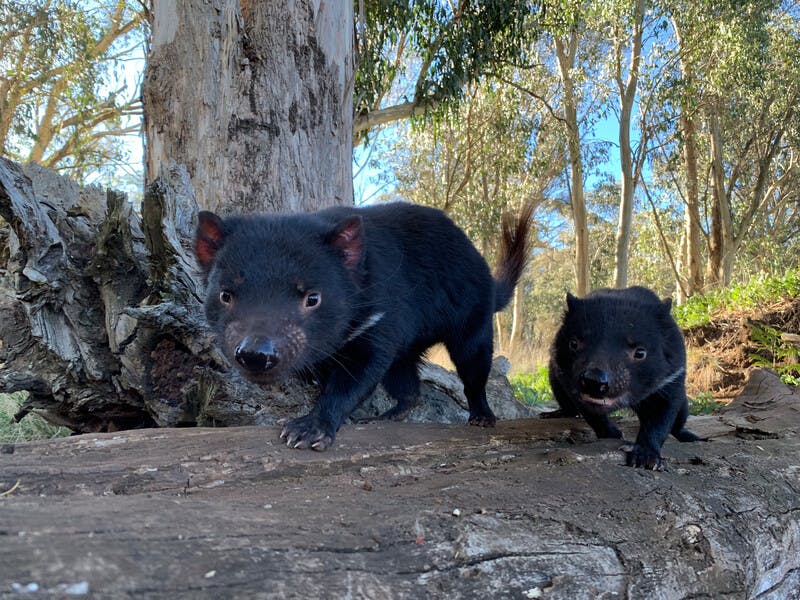Aussie Ark Launches First-ever Conservation Breeding Program for Species, Will Return Juveniles to the Wild

For immediate release
March 17, 2020
After months of drought, extensive fire and flooding have devastated Australia’s east coast, one of the first signals of hope and recovery has come in the form of 10 tiny turtle hatchlings. The clutch of endangered Manning River turtles hatched March 5 and 6, about 48 days after the nest had been rescued from imminent flooding in New South Wales and brought to the Australian Reptile Park, a partner of Aussie Ark. Their hatching in part marks the launch of the first-ever conservation breeding program for the Manning River turtle, a project supported by Global Wildlife Conservation and the Turtle Conservancy.
“Because Manning River turtles were endangered before the fires, we started planning for the conservation breeding program three years ago and happened to have the facilities ready for these emergency rescue efforts when the fires began,” said Tim Faulkner, president of Aussie Ark. “I’ll consider the project a success when we’re returning 200-300 juveniles back to the river system each year, but this is a truly joyful way to kick off those efforts after so much heartache.”
The hatchlings are among the more than 215 individual endangered turtles that Aussie Ark, in partnership with the New South Wales National Parks and Wildlife Service, have rescued since December from the extreme and unprecedented weather conditions. This includes not only the Manning River turtle, but also the Bells’ River turtle and Hunter River turtle. Some of the animals were relocated to deeper pools just as their habitat was drying up, while those in poor health were kept in human care and rehabilitated until they could safely be released back into the wild.
Dan Rumsey, head of reptiles at the Australian Reptile Park, collected the clutch of eggs with permission from the government after a landowner called to report that the nest was at risk of washing away in floods when the rain finally came, and that a fox—the primary invasive predator to Australia’s turtles—was spotted nearby.
“It was a combination of different obvious threats that convinced us the nest would be destroyed if we left it there, and we were confident we would be able to hatch the eggs out in an incubator at the park and safely return them to the wild,” Rumsey said. “Sure enough, I walked in one morning, opened the incubator and there was this brilliant yellow-and-black head sticking out of an egg, and I just thought ‘you beauty!’ It was one of a few rare moments that we’ve felt ecstatic in recent months.”
In addition to these eggs, during the rescue efforts over four months, Aussie Ark collected an adult male, adult female and subadult Manning River turtle for the conservation breeding program. The female laid her own clutch of eggs at the end of February. Those eggs are due to hatch in early April.
Aussie Ark’s Manning River turtle conservation breeding program includes a specialized facility with ponds of 1,000 gallons of water for every three adult turtles. The ponds require all of the normal care of a pool, with regular cleaning, water testing, and filtration system checks. Faulkner plans to return to the field this month to try to collect 17 more turtles to complete the founder population for the conservation breeding program. Ultimately he aims to breed the founders and return 200-300 turtles back to the Manning River each year as part of a strategy to help rewild Australia.
This kind of head start insurance program gets around one of the major threats to Australia’s turtles: introduced feral foxes and cats that feast extensively on turtle eggs, which has resulted in a population of aging turtles and few young turtles to replace them. Those turtles that do hatch successfully are then subject to habitat destruction (primarily for cattle ranching for beef) and disease, often the result of cattle feces that end up in the water in which they live, especially during drier times. Australia listed the Manning River turtle, which is found only in New South Wales in the Manning River, as an endangered species in 2017.
The Aussie Ark team will be monitoring the baby turtles closely and will eventually move them into a nursery of specialized tanks, where they will live for about four months before being moved to small outdoor ponds. In the months after that, Aussie Ark will decide how many turtles will stay in the conservation breeding program, and how many will be released back into the wild—in the exact place the nest was found. Those that are returned to the wild will be fitted with radio transmitters to help the team track dispersal patterns and survivorship rates.
“The Manning River is important for many species and saving the endemic turtle and its habitat is vital for a unique ensemble of fishes and invertebrates,” said Don Church, president of Global Wildlife Conservation. “The turtle is especially vulnerable because it nests terrestrially. Aussie Ark’s actions are now critical to preventing its extinction.”
# # #
Photo: Ten Manning River turtles hatched from a clutch collected in the wild at imminent threat from flooding, invasive predators and cattle. (Photo courtesy of Aussie Ark)
Aussie Ark
As a not for profit organisation, Aussie Ark raises the necessary funds to continue its ambitious vision. Investment allows for the construction of captive facilities andpredator proof fencing on semi-wild parcels of land. Aussie Ark is a registered environmental organisation and charitable institution under the Australian Charity and Not-for-Profit Commission. Aussie Ark has deductible gift recipient status (DGR status) and is registered for GST purposes. More information at www.aussieark.org.au
Global Wildlife Conservation
GWC conserves the diversity of life on Earth by safeguarding wildlands, protecting wildlife and supporting guardians. We maximize our impact through scientific research, biodiversity exploration, habitat conservation, protected area management, wildlife crime prevention, endangered species recovery, and conservation leadership cultivation. Learn more at https://globalwildlife.org
Turtle Conservancy
The Turtle Conservancy is dedicated to protecting threatened turtles and tortoises and their habitats worldwide. It focuses its work on four strategic program areas: conserving species in their natural habitat, including land acquisition; maintaining captive breeding programs to help restore natural populations; conservation science and research; outreach and spreading global awareness; and monitoring and helping to prevent trade that threatens turtle and tortoise species. Learn more at www.turtleconservancy.org
Contact
Lindsay Renick Mayer
Global Wildlife Conservation
lrenickmayer@globalwildlife.org
512-686-6225
Brodie Chiswick
Aussie Ark
admin@aussieark.org.au
0431 085 913
James Liu
Turtle Conservancy
408-741-4825

 BACK TO PRESS
BACK TO PRESS
